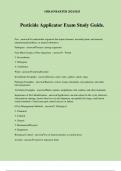©BRAINBARTER 2024/2025
Pesticide Applicator Exam Study Guide.
Pest - answer✔An undesirable organism that injures humans, desirable plants and animals,
manufactured products, or natural substances
Pathogens - answer✔Disease causing organisms
Four Main Groups of Pest Organisms - answer✔1. Weeds
2. Invertebrates
3. Pathogens
4. Vertebrates
Weed - answer✔Undesirable plant
Invertebrate Examples - answer✔Insects, mites, ticks, spiders, snails, slugs
Pathogen Examples - answer✔Bacteria, viruses, fungi, nematodes, mycoplasmas, and other
microorganisms
Vertebrate Examples - answer✔Birds, reptiles, amphibians, fish, rodents, and other mammals
Importance of Pest Identification - answer✔Applicators can learn about its life cycle, behavior,
characteristic damage, factors that favor its development, susceptible life stages, and known
control methods. Could cause pest control success or failure.
6 Pest Management Methods - answer✔1. Biological
2. Chemical
3. Cultural
4. Genetic
5. Mechanical/Physical
6. Regulatory
Biological Control - answer✔Use of natural enemies to control pests.
Avicide - answer✔Control or repel pest birds
, ©BRAINBARTER 2024/2025
Bactericide - answer✔Control bacteria
Chemosterilants - answer✔Sterilize insects or pest vertebrates
Defoliants - answer✔Causes leaves to drop from plants
Desiccants - answer✔Promote drying or loss of moisture from plant tissues and insects
Disinfectants - answer✔Control microorganisms
Fungicide - answer✔Control fungi
Growth Regulators - answer✔Alter growth or development of plant or animal
Herbicide - answer✔Control weeds
Insecticide - answer✔Control insects and related arthropods
Miticide - answer✔(Acaricide) Control mites
Molluscicides - answer✔Control snails and slugs
Nematicides - answer✔Control nematodes
Ovicides - answer✔Destroy eggs
Pheromone - answer✔Attract insects
Piscicides - answer✔Control pest fish
Predacides - answer✔Control predatory vertebrates
Repellants - answer✔Repel insects, mites, ticks, pest vertebrates, invertebrates, birds, and
mammals
Rodenticides - answer✔Controls rodents
Selective Pesticide - answer✔Toxic to some pests, but have little or no effect on others
Systemic Pesticide - answer✔Absorbed and translocated within a plant or animal
Contact Pesticide - answer✔Must directly touch the pest or a site the pest frequents
Persistence - answer✔How long a pesticide remains actives to control pest
Residual Pesticides - answer✔Control pests long term (ie weeks, months, or years)
, ©BRAINBARTER 2024/2025
Cultural Control - answer✔Practices that reduce pest establishment, reproduction, dispersal, and
survival
Examples of Cultural Controls - answer✔Mowing, irrigation, aeration, fertilization, crop
selection, etc.
Genetic Control - answer✔Selected or bred to resists specific pests
Mechanical Control - answer✔Kill a pest directly or make its environmental unsuitable
Examples of Mechanical Control - answer✔Traps, mulches, fences, cloth mesh, etc.
Quarantine - answer✔Pest control process designed to prevent entry of certain pests into pest-
free areas
Eradication - answer✔Elimination of a pest from a designated area
Integrated Pest Management - answer✔Strategy that utilizes a wide range of pest control tactics
to prevent pests from reaching economically or aesthetically damaging levels with the least risk
to the environment
Why Practice IPM (5) - answer✔1. Balanced ecosystem.
2. Pesticides can be ineffective.
3. Can save money.
4. Promotes healthy environment.
5. Maintains good public image.
5 Components of IPM - answer✔1. Identify the pest and understand its biology
2. Monitor the pest to be managed
3. Develop pest management goal
4. Implement program
5. Record and evaluate results
Key Pests - answer✔May cause major damage on regular basis unless they are controlled
Secondary Pest - answer✔Become pests when key pests are controlled or absent
Occasional Pest - answer✔Sporadically become problematic due to life cycles, environmental
influences, or as a result of human activities




